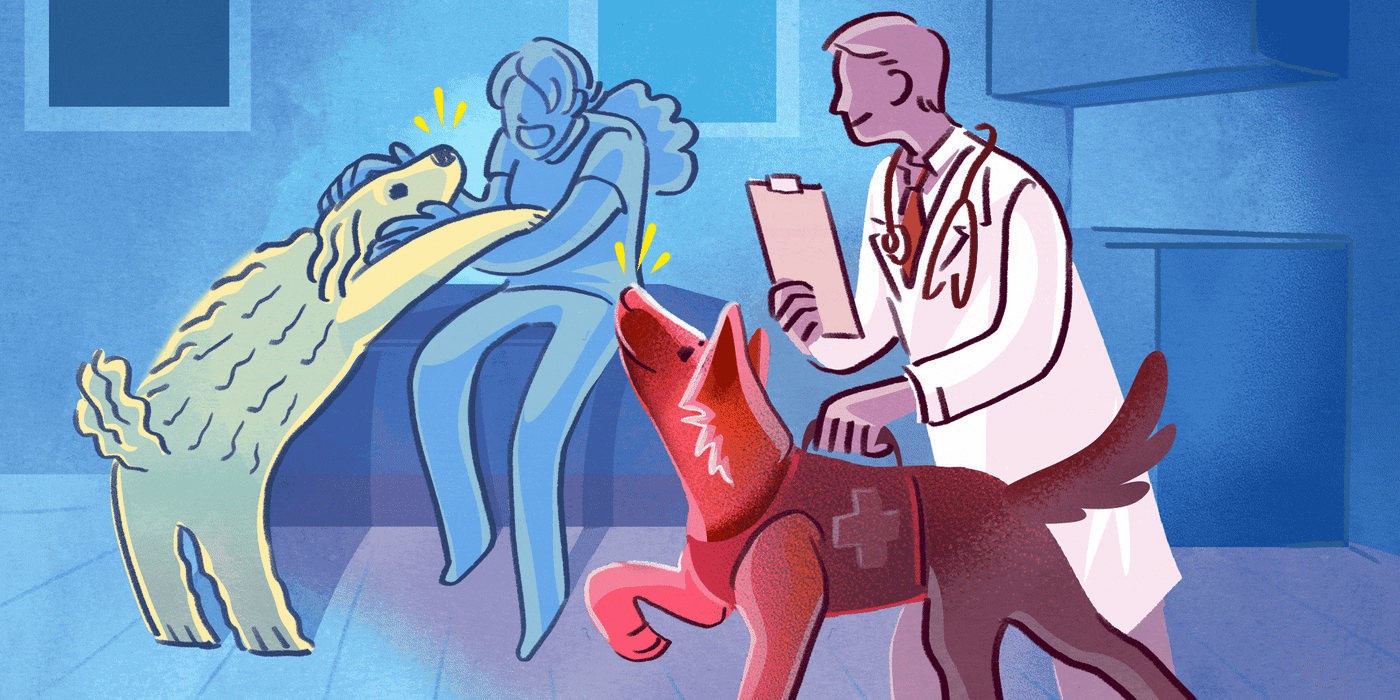My roommate and I are no strangers to late-night dinner conversations, which occur, more often than not, at the kitchen counter, the two of us still dressed in the day’s scrubs. Over tacos and ice cream, we usually talk about our respective days in the health care field. I share about how my patient is recovering from major surgery while she shows me videos of her patients, who are usually more adorable and covered in fur.
As a veterinary student, she and I have had many interesting and thought-provoking conversations over the years. As much as humans and animals share similar physiology and biology, I have come to learn that there are many differences between the two fields. Her dog is on 12 milligrams of lorazepam daily, a staggering amount that would sedate even the largest human. When conducting an exploratory laparotomy to evaluate small bowel obstruction, we often “run the bowel” on the patient’s abdomen, carefully checking for adhesions. Horses with a similar affliction are meticulously evaluated using a 25-foot metal tray to organize the entire length of the intestines. It is intriguing to compare; I’ve realized how distinct animal medicine is from human medicine, down to debates on ethical issues. But time and time again, my roommate and I find ourselves returning to the same topic: how can humans and animals collaborate to improve diagnosis, detect disease, and potentially forge cures?
Long ago, before the advent of genetic carrier testing and flow cytometry, detecting an illness often required more than the sense of sight. From the sweet-smelling urine of diabetic patients to the freshly baked brown bread scent of typhoid, some diseases were distinguished by their unusual odors. Even in seemingly healthy patients, volatile organic compounds are emitted from the body in the form of breath and fluids, and often reflect the metabolic condition of the human. While modern medicine has diminished the role of smell in diagnosing patients (to my and every other health care professional’s relief), this is a void that animals might potentially fill. Dogs are great biosensors, with the capacity for odor detection up to 10,000–100,000 times that of an average human. While we may not be able to detect minute changes in odor, dogs have highly evolved anatomical differences with increased brain capacity for odor and pheromone detection. Studies have shown that dogs have been used to detect cases of cervical cancer, lung cancer, breast cancer, and even colorectal cancer. Of course, these cancers have adequate screening tests and guidelines — but what about an entity that is notoriously more difficult to detect?
Ovarian cancer is infamously dubbed the “silent killer” due to its constellation of nonspecific symptoms (bloating, abdominal discomfort, indigestion), which often leads to delayed diagnosis and treatment. It is the leading cause of cancer-related death among gynecologic malignancies and ranks fifth in cancer deaths among women. Due to the disease’s tendency to advanced rapidly upon initial presentation, the five-year relative survival rate is less than 50%, despite recent advances in treatment including cytoreductive surgery, chemoradiation, and targeted therapy. If detected early, however, the cancer can be treated, with local-stage disease survival rates of up to 93%. Thus, the quest to develop inexpensive and safe screening measures for early detection is paramount.
Though still a relatively young field, research on odor detection in ovarian cancer is already in progress. Scientists have been able to isolate a specific odor associated with ovarian malignancy, distinct from odors related to general inflammation or cancer metabolic products. This odor was readily detectable in cancer tissues and blood from patients with ovarian carcinoma by two specially trained dogs with high sensitivity and specificity. Perhaps the most enlightening application is the use of olfactory detection to monitor treatment success and recurrence. A subset of patients was monitored at three and six months after the last course of chemotherapy — in three of the 10 patients, dogs indicated positive samples at both time points, with all three patients eventually presenting with recurrence.
While these preliminary studies are based on a limited number of patients, canine detection of ovarian malignancies represents a potential strategy to improve diagnostic ability and, hopefully, morbidity and mortality. Pending reliable and reproducible results with larger cohorts, olfactory detection could be a non-invasive, simple, and easy tool to augment screening and monitor relapse. Beyond the promising initial data, such an approach fosters interdisciplinary collaboration and partnership. Increased exposure to different thought processes and unique training models is mutually beneficial, allowing for multiple perspectives on the same problem.
As always, the implementation of new technology will require weighing the benefits against the risks. Training dogs can be expensive, and measures to ensure ethical, safe, and effective delivery in human medicine is crucial. There are places where dogs may not be universally welcome, either due to hygiene issues, anxiety surrounding animals, or for religious reasons. Perhaps, however, the bigger question is whether it is worth the resource and time investment that training dogs would require, or whether efforts should be focused elsewhere on improving diagnostic screening and/or therapies.
Olfaction detection will continue to be a unique, joint animal-human area of research. In the midst of the novel COVID-19 pandemic, a study of nine dogs at the University of Pennsylvania found success in identifying humans infected with the virus while controlling for potential confounders. Other applications in progress include detecting biofilm infections, sinonasal papillomas, and environmental threats like the spotted lanternfly. Regardless of whether you believe that resources should be diverted elsewhere, olfactory detection represents a unique therapeutic alliance between the fields of animal and human medicine. So, the next time you look at Charlie or Fido, make sure to give them an extra pet to thank them for all the work their cousins are doing.
Do you think the presence of animals in your practice would be well-received by patients and staff? Share your thoughts about an alliance between animal and human medicine in the comments!
Originally from Chicago, Beatrice is currently a fourth-year medical student at the University of Pennsylvania Perelman School of Medicine interested in applying into otolaryngology. As an avid painter and artist, she is interested in the intersection of art and medicine, particularly within the context of improving surgical care and patient education. Outside of medicine, she enjoys cooking, drawing, powerlifting, and trying new restaurants in Philly. Beatrice is a 2020–2021 Doximity Op-Med Fellow.
Illustration by April Brust







